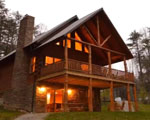BARKCAMP STATE PARK
Belmont County's rugged hills provide the backdrop for picturesque Barkcamp State Park. In addition to fine recreational facilities, visitors will enjoy the mature woodlands, open meadows, scenic lake and abundant wildlife of this secluded park.
The sandstone hills of the Barkcamp region are part of the Appalachian highlands which envelop the southeastern part of Ohio. In the sandstone bedrock can be found layers of coal which were formed by decaying swamp vegetation millions of years ago during the Pennsylvanian geologic period. Barkcamp State Park lies in the heart of the coal-mining region of Ohio.
The hills and valleys of the area are clothed with a second-growth forest. Today, southeastern Ohio is one of the most extensively forested in Ohio, and only a few areas remain which suggest the magnificence of these original forests.
The woodlands of Barkcamp support a variety of plant and animal life. The observant visitor may find a wealth of woodland wildflowers including wild geranium, hepatica, bloodroot and spring beauties. The woodlands explode with flowering dogwood and redbud blossoms in spring.
Songbirds, squirrels, skunk, opossum, raccoon, white-tailed deer and the wild turkey take up residence in the park's varying habitats.
This area was first inhabited by the Moundbuilders, then later by Wyandots, Delaware and Shawnee. Belmont County was one of the earliest areas settled in Ohio, and the scene of several bloody conflicts between settlers and Indians. Prior to the Treaty of Greenville of 1795, the nearby Ohio River was the accepted boundary between Indians to the north and settlers to the south of the river. Conflicts arose as land-hungry settlers began encroaching on Indian lands. The celebrated Indian fighter, Lewis Wetzel, was often through this region. Wetzel instigated many of the conflicts as Indians were the object of his mortal hate. A large boulder near the park's Antique Barn bears an inscription carved by Wetzel.
The Society of Friends (Quakers) established the first church in the area. Benjamin Lundy, a Quaker who lived in St. Clairsville, became known as the "Father of Abolitionism." He formed an anti-slavery society here in 1815 called the Union Humane Society. At one point, there were 120 miles of the Underground Railroad in Belmont County. Lundy helped produce the abolitionist paper, The Philanthropist at nearby Mt. Pleasant.
As years passed, coal was discovered and became the foundation of the area's economy. Belmont County is now the state's leading producer of coal with an estimated 5,668 million tons of coal available below the earth's surface.
Land acquisition began for the park in 1955, and a dam was completed in 1963 resulting in the 117-acre Belmont Lake. The park derives its unusual name from Barkcamp Creek, the former site of a logging camp where logs were stripped of their bark in preparation for delivery to the mill.
Ohio does not have an annual pass and does not charge entrance fees to state parks.
GeneralLand, acres1,005
Water, acres117
Day-UseFishingyes
Huntingyes
Hiking Trail, miles4
Picnickingyes
Picnic Shelters, #3
Swimming Beach, feet700
Mountain Bike Trails, miles6
Bridle Trails, miles24
Nature Centeryes
Nature Programsyes
BoatingBoating Limits-1
Seasonal Dock Rental36
Launch Ramps, #1
CampingElectric Sites, #150
Pets Permittedyes
Dumpstationyes
Showersyes
Rent-A-Camp Sites, #3
Camper Cabins, #2
Group Camp, capacity25
Horsemen Campsites, #27
WinterSleddingyes
Cross-Country Skiingyes
Snowmobilingyes
Ice Boatingyes
Ice Skatingyes
Ice Fishingyes
Barkcamp offers 150 electrified campsites in sunny and shaded areas. The campground features hot showers, tables, firerings, two wheelchair accessible sites and a dump station. A group camp that accommodates 15 sites is available for organized groups by reservation. In addition, a horseman's camp with 25 sites is available. Five Rent-A-Camp units consisting of a tent, dining canopy, cooler, cookstove and other equipment can be rented during the summer months by reservation. Pet camping is permitted on designated sites.
A 700-foot beach provides enjoyment for swimmers and sunbathers.
Boats with electric motors only are permitted on Belmont Lake. Seasonal boat tie-ups are available. A launch ramp provides access to the lake.
Barkcamp State Park in Ohio offers a variety of fishing options for both experienced and novice anglers. The park's 117-acre Belmont Lake is stocked with several species of fish, including largemouth bass, bluegill, crappie and catfish which makes it an ideal spot for freshwater fishing. Fishing from the shoreline or boat are popular activities at this lake.
The park also provides two accessible fishing piers that cater to individuals with mobility issues ensuring everyone can enjoy the sport. Boating facilities include launch ramps available on site making it easy to get out onto the water quickly.
In addition to these amenities, Barkcamp State Park allows night-fishing giving enthusiasts more opportunities not only during daytime but after sunset as well.
For those who prefer fly-fishing over traditional rod-and-reel methods; there's plenty of space along shorelines where they could cast their lines too.
However please note all fishermen aged 16 years old and above must have valid Ohio state licenses before engaging in any kind of angling activity within Barkcamp State Park boundaries according rules set by Department Of Natural Resources Division Of Wildlife (DNR).



